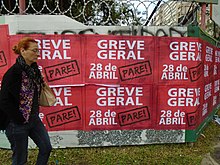
The 2017 Brazilian general strike took place on 28 April, 100 years after Brazil's first general strike in June 1917.[1] The movement was a protest against reforms of labor laws, which were later adopted and social security proposed by Michel Temer government and pending in National Congress of Brazil.[2][3][4]
More than 150 cities recorded stoppages,[5] and according to the organizers, there were 40 million people,[6] with no official admission balance or the number of protesters on the streets.[5] With wide coverage in international media,[7] the strike was minimized by the Brazilian press according to the journalist Paula Cesarino Costa, with emphasis given to conflicts between police and strikers.[8] With diverse reactions, politicians who support the government reduced the impact of the strike while oppositionists defended it as popular expression.[9][10][11] Political scientist Marco Antonio Teixeira, in an interview for the BBC, said that the strike was "smaller than organizers expected, but larger than the government would like".[5]
- ^ "1ª greve geral do País, há 100 anos, foi iniciada por mulheres e durou 30 dias". Terra Notícias.
{{cite journal}}: Cite journal requires|journal=(help) - ^ "Greve geral: as paralisações desta sexta pelo país". Veja. 28 April 2017. Retrieved 28 April 2017.
- ^ "Greve geral: veja o que não vai funcionar nesta sexta-feira, 28 de abril". El País.
- ^ "Os motivos da greve geral desta sexta (28/04)". Exame. 28 April 2017. Retrieved 28 April 2017.
- ^ a b c "'Greve foi menor do que organizadores esperavam, mas maior do que governo gostaria', diz cientista político". BBC. 29 April 2017.
Não houve um balanço oficial sobre a quantidade de pessoas que aderiram à greve ou sobre os protestos espalhados nas principais capitais brasileiras
- ^ "Greve geral reúne 40 milhões de trabalhadores, dizem sindicatos". Exame. 28 April 2017.
- ^ Cite error: The named reference
intFolhawas invoked but never defined (see the help page). - ^ Paula Cesarino Costa (30 April 2017). "A imprensa e a greve geral". Folha de S. Paulo. Retrieved 5 May 2017.
- ^ Cite error: The named reference
reacoesUOLwas invoked but never defined (see the help page). - ^ Cite error: The named reference
ODiawas invoked but never defined (see the help page). - ^ Cite error: The named reference
reacoesEpocawas invoked but never defined (see the help page).